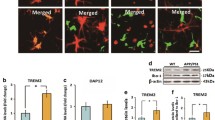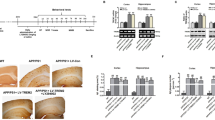Abstract
As a recently identified susceptibility gene for Alzheimer’s disease (AD), triggering receptor expressed on myeloid cells 2 (TREM2) encodes an immune receptor that is uniquely expressed on microglia, functioning as a modulator of microglial functions including phagocytosis and inflammatory response. Several lines of evidence suggest that TREM2 is upregulated and positively correlates with tau pathology in the brains of AD patients. Meanwhile, our recent study showed that knockdown of TREM2 markedly exacerbated neuronal tau hyperphosphorylation in the brains of P301S-tau transgenic mice, implying that TREM2 might exert a protective role against tau pathology under AD context. However, the precise mechanisms underlying this observation remain largely unclear. In this study, by employing a microglial-neuronal co-culture model, we showed that microglial inflammatory response induced by lipopolysaccharide led to tau hyperphosphorylation in neurons via activation of a major tau kinase glycogen synthase kinase 3β, confirming the pathogenic effects of activated microglia on the progression of tau pathology. More importantly, by manipulating TREM2 levels in microglia with a lentiviral-mediated strategy, we demonstrated that TREM2 ameliorated the pathological effects of activated microglia on neuronal tau hyperphosphorylation via suppression of microglial inflammatory response. Taken together, these findings uncover the underlying mechanisms by which TREM2 protects against tau pathology and highlight TREM2 as a potential therapeutic target for AD.






Similar content being viewed by others
References
Cruchaga, C., J.S. Kauwe, O. Harari, S.C. Jin, Y. Cai, C.M. Karch, B.A. Benitez, et al. 2013. GWAS of cerebrospinal fluid tau levels identifies risk variants for Alzheimer’s disease. Neuron 78 (2): 256–268. https://doi.org/10.1016/j.neuron.2013.02.026.
Giannakopoulos, P., F.R. Herrmann, T. Bussiere, C. Bouras, E. Kovari, D.P. Perl, J.H. Morrison, G. Gold, and P.R. Hof. 2003. Tangle and neuron numbers, but not amyloid load, predict cognitive status in Alzheimer’s disease. Neurology 60 (9): 1495–1500.
Guerreiro, R., A. Wojtas, J. Bras, M. Carrasquillo, E. Rogaeva, E. Majounie, C. Cruchaga, et al. 2013. TREM2 variants in Alzheimer’s disease. The New England Journal of Medicine 368 (2): 117–127. https://doi.org/10.1056/NEJMoa1211851.
Hamerman, J.A., J.R. Jarjoura, M.B. Humphrey, M.C. Nakamura, W.E. Seaman, and L.L. Lanier. 2006. Cutting edge: inhibition of TLR and FcR responses in macrophages by triggering receptor expressed on myeloid cells (TREM)-2 and DAP12. Journal of Immunology 177 (4): 2051–2055.
Honson, N.S., and J. Kuret. 2008. Tau aggregation and toxicity in tauopathic neurodegenerative diseases. Journal of Alzheimer’s Disease 14 (4): 417–422.
Hsieh, C.L., M. Koike, S.C. Spusta, E.C. Niemi, M. Yenari, M.C. Nakamura, and W.E. Seaman. 2009. A role for TREM2 ligands in the phagocytosis of apoptotic neuronal cells by microglia. Journal of Neurochemistry 109 (4): 1144–1156. https://doi.org/10.1111/j.1471-4159.2009.06042.x.
Ito, H., and J.A. Hamerman. 2012. TREM-2, triggering receptor expressed on myeloid cell-2, negatively regulates TLR responses in dendritic cells. European Journal of Immunology 42 (1): 176–185. https://doi.org/10.1002/eji.201141679.
Jiang, T., L. Tan, X.C. Zhu, Q.Q. Zhang, L. Cao, M.S. Tan, L.Z. Gu, et al. 2014. Upregulation of TREM2 ameliorates neuropathology and rescues spatial cognitive impairment in a transgenic mouse model of Alzheimer’s disease. Neuropsychopharmacology 39 (13): 2949–2962. https://doi.org/10.1038/npp.2014.164.
Jiang, T., L. Tan, X.C. Zhu, J.S. Zhou, L. Cao, M.S. Tan, H.F. Wang, Q. Chen, Y.D. Zhang, and J.T. Yu. 2015. Silencing of TREM2 exacerbates tau pathology, neurodegenerative changes, and spatial learning deficits in P301S tau transgenic mice. Neurobiology of Aging 36 (12): 3176–3186. https://doi.org/10.1016/j.neurobiolaging.2015.08.019.
Jiang, T., J.T. Yu, X.C. Zhu, and L. Tan. 2013. TREM2 in Alzheimer’s disease. Molecular Neurobiology 48 (1): 180–185. https://doi.org/10.1007/s12035-013-8424-8.
Jiang, T., J.T. Yu, X.C. Zhu, M.S. Tan, L.Z. Gu, Y.D. Zhang, and L. Tan. 2014. Triggering receptor expressed on myeloid cells 2 knockdown exacerbates aging-related neuroinflammation and cognitive deficiency in senescence-accelerated mouse prone 8 mice. Neurobiology of Aging 35 (6): 1243–1251. https://doi.org/10.1016/j.neurobiolaging.2013.11.026.
Jiang, T., J.T. Yu, X.C. Zhu, Q.Q. Zhang, L. Cao, H.F. Wang, M.S. Tan, et al. 2014. Temsirolimus attenuates tauopathy in vitro and in vivo by targeting tau hyperphosphorylation and autophagic clearance. Neuropharmacology 85: 121–130. https://doi.org/10.1016/j.neuropharm.2014.05.032.
Jiang, T., Y.D. Zhang, Q. Chen, Q. Gao, X.C. Zhu, J.S. Zhou, J.Q. Shi, H. Lu, L. Tan, and J.T. Yu. 2016. TREM2 modifies microglial phenotype and provides neuroprotection in P301S tau transgenic mice. Neuropharmacology 105: 196–206. https://doi.org/10.1016/j.neuropharm.2016.01.028.
Jiang, T., Y.D. Zhang, Q. Gao, J.S. Zhou, X.C. Zhu, H. Lu, J.Q. Shi, L. Tan, Q. Chen, and J.T. Yu. 2016. TREM1 facilitates microglial phagocytosis of amyloid beta. Acta Neuropathologica 132 (5): 667–683. https://doi.org/10.1007/s00401-016-1622-5.
Jonsson, T., H. Stefansson, S. Steinberg, I. Jonsdottir, P.V. Jonsson, J. Snaedal, S. Bjornsson, et al. 2013. Variant of TREM2 associated with the risk of Alzheimer’s disease. The New England Journal of Medicine 368 (2): 107–116. https://doi.org/10.1056/NEJMoa1211103.
Khanna, M.R., J. Kovalevich, V.M. Lee, J.Q. Trojanowski, and K.R. Brunden. 2016. Therapeutic strategies for the treatment of tauopathies: hopes and challenges. Alzheimers Dement 12 (10): 1051–1065. https://doi.org/10.1016/j.jalz.2016.06.006.
Klesney-Tait, J., I.R. Turnbull, and M. Colonna. 2006. The TREM receptor family and signal integration. Nature Immunology 7 (12): 1266–1273. https://doi.org/10.1038/ni1411.
Lee, D.C., J. Rizer, M.L. Selenica, P. Reid, C. Kraft, A. Johnson, L. Blair, M.N. Gordon, C.A. Dickey, and D. Morgan. 2010. LPS- induced inflammation exacerbates phospho-tau pathology in rTg4510 mice. Journal of Neuroinflammation 7: 56. https://doi.org/10.1186/1742-2094-7-56.
Lee, M., E. McGeer, and P.L. McGeer. 2015. Activated human microglia stimulate neuroblastoma cells to upregulate production of beta amyloid protein and tau: implications for Alzheimer’s disease pathogenesis. Neurobiology of Aging 36 (1): 42–52. https://doi.org/10.1016/j.neurobiolaging.2014.07.024.
Li, Y., L. Liu, S.W. Barger, and W.S. Griffin. 2003. Interleukin-1 mediates pathological effects of microglia on tau phosphorylation and on synaptophysin synthesis in cortical neurons through a p38-MAPK pathway. The Journal of Neuroscience 23 (5): 1605–1611.
Liu, S., Y. Liu, W. Hao, L. Wolf, A.J. Kiliaan, B. Penke, C.E. Rube, et al. 2012. TLR2 is a primary receptor for Alzheimer’s amyloid beta peptide to trigger neuroinflammatory activation. Journal of Immunology 188 (3): 1098–1107. https://doi.org/10.4049/jimmunol.1101121.
Lue, L.F., C.T. Schmitz, G. Serrano, L.I. Sue, T.G. Beach, and D.G. Walker. 2015. TREM2 protein expression changes correlate with Alzheimer’s disease neurodegenerative pathologies in post-mortem temporal cortices. Brain Pathology 25 (4): 469–480. https://doi.org/10.1111/bpa.12190.
Ma, J., T. Jiang, L. Tan, and J.T. Yu. 2015. TYROBP in Alzheimer’s disease. Molecular Neurobiology 51 (2): 820–826. https://doi.org/10.1007/s12035-014-8811-9.
Neumann, H., and M.J. Daly. 2013. Variant TREM2 as risk factor for Alzheimer’s disease. The New England Journal of Medicine 368 (2): 182–184. https://doi.org/10.1056/NEJMe1213157.
Sun, X.Y., Y.P. Wei, Y. Xiong, X.C. Wang, A.J. Xie, X.L. Wang, Y. Yang, et al. 2012. Synaptic released zinc promotes tau hyperphosphorylation by inhibition of protein phosphatase 2A (PP2A). The Journal of Biological Chemistry 287 (14): 11174–11182. https://doi.org/10.1074/jbc.M111.309070.
Takahashi, K., M. Prinz, M. Stagi, O. Chechneva, and H. Neumann. 2007. TREM2-transduced myeloid precursors mediate nervous tissue debris clearance and facilitate recovery in an animal model of multiple sclerosis. PLoS Medicine 4 (4): e124. https://doi.org/10.1371/journal.pmed.0040124.
Takahashi, K., C.D. Rochford, and H. Neumann. 2005. Clearance of apoptotic neurons without inflammation by microglial triggering receptor expressed on myeloid cells-2. The Journal of Experimental Medicine 201 (4): 647–657. https://doi.org/10.1084/jem.20041611.
Yoshiyama, Y., M. Higuchi, B. Zhang, S.M. Huang, N. Iwata, T.C. Saido, J. Maeda, T. Suhara, J.Q. Trojanowski, and V.M. Lee. 2007. Synapse loss and microglial activation precede tangles in a P301S tauopathy mouse model. Neuron 53 (3): 337–351. https://doi.org/10.1016/j.neuron.2007.01.010.
Funding
This work was supported by the National Natural Science Foundation of China (81501092, 81500916), Natural Science Foundation of Jiangsu Province (BK20150091), “Six Talent Summit” Foundation of Jiangsu Province (2016-WSN-180), Youth Medical Talent Program of Jiangsu Province (QNRC2016068, QNRC2016079), Medical Innovation Team of Jiangsu Province (CXTDA2017030), and Nanjing Medical Science and Technology Development Foundation for Distinguished Young Scholars (JQX17008).
Author information
Authors and Affiliations
Corresponding authors
Ethics declarations
All procedures performed in this study involving animals were in accordance with the ethical standards of Nanjing First Hospital.
Conflict of Interest
The authors declare that there is no conflict of interest.
Electronic supplementary material
Rights and permissions
About this article
Cite this article
Jiang, T., Zhang, YD., Gao, Q. et al. TREM2 Ameliorates Neuronal Tau Pathology Through Suppression of Microglial Inflammatory Response. Inflammation 41, 811–823 (2018). https://doi.org/10.1007/s10753-018-0735-5
Published:
Issue Date:
DOI: https://doi.org/10.1007/s10753-018-0735-5




